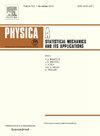Critical phenomena in a spin-1/2 Baxter–Wu triangular multilayers with Ising-like coupling
IF 2.8
3区 物理与天体物理
Q2 PHYSICS, MULTIDISCIPLINARY
Physica A: Statistical Mechanics and its Applications
Pub Date : 2025-01-27
DOI:10.1016/j.physa.2025.130397
引用次数: 0
Abstract
Our research focuses on the creation of a 3D layered system model that adheres to a three-spin Baxter–Wu-like interaction. To address the phase transition problem, we use entropic sampling simulations to construct the density of states and analyze various quantities such as the total magnetization, average energy, magnetic susceptibility, energy probability distribution function, and inverse microcanonical temperature. Once we established that the system undergoes a first-order phase transition, we carried out a finite-size scaling procedure by carefully studying the critical behavior of the minimum temperature of cumulants for energy and magnetization. We also computed the pseudocritical temperature, , which is the temperature where the energy density probability distribution has a double peak. Based on our analysis, we were able to obtain an estimation of the transition temperature as and the latent heat value at this point.
求助全文
约1分钟内获得全文
求助全文
来源期刊
CiteScore
7.20
自引率
9.10%
发文量
852
审稿时长
6.6 months
期刊介绍:
Physica A: Statistical Mechanics and its Applications
Recognized by the European Physical Society
Physica A publishes research in the field of statistical mechanics and its applications.
Statistical mechanics sets out to explain the behaviour of macroscopic systems by studying the statistical properties of their microscopic constituents.
Applications of the techniques of statistical mechanics are widespread, and include: applications to physical systems such as solids, liquids and gases; applications to chemical and biological systems (colloids, interfaces, complex fluids, polymers and biopolymers, cell physics); and other interdisciplinary applications to for instance biological, economical and sociological systems.

 求助内容:
求助内容: 应助结果提醒方式:
应助结果提醒方式:


